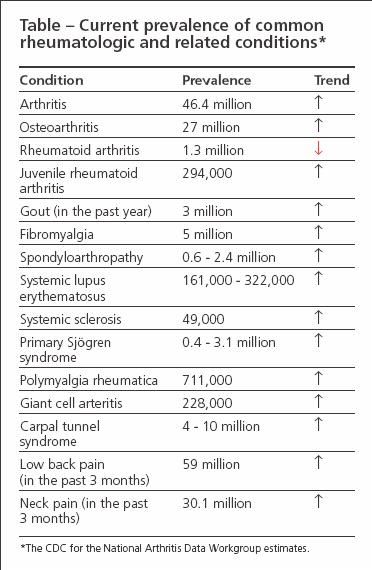Article
Arthritis on the rise: A large and growing problem
The number of persons with arthritis or another rheumatologic condition is expected to climb to 67 million-a whopping 44% increase-by the year 2030, according to a new study released by the CDC for the National Arthritis Data Workgroup (NADW). The prevalence of osteoarthritis, the most common form of arthritis, has increased to about 27 million persons, up from an estimated 21 million in 1990, showing a 29% increase. Gout now affects about 3 million adults, representing a 43% increase. Of all the common rheumatologic conditions, only rheumatoid arthritis (RA) has decreased in prevalence (Table).
The number of persons with arthritis or another rheumatologic condition is expected to climb to 67 million-a whopping 44% increase-by the year 2030, according to a new study released by the CDC for the National

Arthritis Data Workgroup (NADW). The prevalence of osteoarthritis, the most common form of arthritis, has increased to about 27 million persons, up from an estimated 21 million in 1990, showing a 29% increase. Gout now affects about 3 million adults, representing a 43% increase. Of all the common rheumatologic conditions, only rheumatoid arthritis (RA) has decreased in prevalence (Table).
The NADW is a consortium of experts in epidemiology organized to provide a single source of national data on the prevalence and impact of rheumatologic diseases. The 2-part study, “Estimates of the Prevalence of Arthritis and Other Rheumatic Conditions in the United States,” used published research to estimate the num=ber of persons affected in 2005 by more than 100 diseases and conditions that involve the joints.
Other highlights of the study findings include the following:
·More than 46 million persons currently have arthritis, representing close to 1 of 5 US adults.
·Close to two thirds of the patients for whom a physician made a diagnosis of arthritis are younger than 65 years.
·About 1.3 million adults have RA, compared with 2.1 million in 1990. More restrictive classification criteria are cited as a reason for this apparent decline in prevalence, along with an actual decrease, for which there was no explanation.
The researchers attributed the increasing prevalence of arthritis and other rheumatologic disorders to the age-related nature of many specific conditions and the ongoing aging of the US population. They predicted a growing burden on the health care and public health systems and suggested that more efforts are needed to promote interventions and programs to reduce the burden.
For more information about the NADW study, visit the CDC Web site at http://www.cdc.gov/arthritis. Or, contact the organization at National Center for Chronic Disease Prevention and Health Promotion, Division of Adult and Community Health, Health Care and Aging Studies Branch, Arthritis Section, Mailstop K-51, 4770 Buford Highway NE, Atlanta, GA 30341-3724; telephone: (770) 488-5464; fax: (770) 488-5964; e-mail: arthritis@cdc.gov




